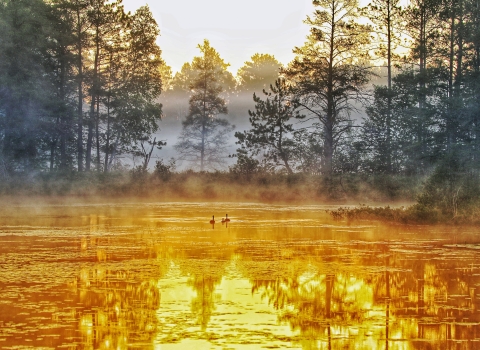Bat Week has arrived, October 24-31, 2022, and we're joining with international partners in celebrating the wonders of bats – allies often unnoticed, and sometimes misunderstood. Superheroes of the natural world, bats have long intrigued and amazed us. Their feats can astound –horizontal flight speeds of 100+ mph in some species, the ability to eat their body weight in insects each night. But so rarely do we get to see them in action.
Despite their nocturnal and mysterious nature, bats are all around us – in cities, forests, wetlands, fields, and everywhere on Earth except the most extreme deserts and polar regions. Bats account for nearly 20% of all mammal species. Of the world’s 1,400+ species of bats, 47 call the continental U.S. home.
Bats are of vital importance to the health of our natural environment, economies, and human communities. Their insect-eating prowess saves American farmers more than $3 billion in pest control each year, reducing pesticide use and protecting the health of our fields, forests, gardens, and waters. Pollinating and seed-dispersing bats give us such treats as mangoes, coffee, guavas, bananas, cloves, and agave.
Yet as many North American bats settle into hibernation, they begin another winter threatened by white-nose syndrome (WNS). Caused by an invasive and cold-loving fungus, WNS has killed many millions of bats since 2006, making it one of the deadliest wildlife diseases on the continent. The fungus has caused signs of disease in 12 species of bats across 38 states and led to precipitous declines of tricolored and northern long-eared bats. In 2022, the Service proposed to list both species as endangered due to WNS.
Working with an array of partners, the U.S. Fish and Wildlife Service leads the coordinated national response to WNS. Through an international effort that includes more than 150 nongovernmental organizations, universities, Tribes, and federal, state, provincial, and territorial agencies, we guide a continual push for innovation and research that has yielded promising treatments to slow the disease and improve bat survival.
We are monitoring bat populations and the effects of management and other conservation actions through the North American Bat Monitoring Program (NABat). Co-led by USGS and the Service, NABat has consolidated nearly 68 million records from partners in 49 states, eight Canadian provinces, and 10 Tribal organizations. NABat integrates the best available science and data to inform decision making in our delivery of conservation.
One of the latest efforts, which we think holds great promise for producing enduring solutions – a biotech research grant opportunity. We’re seeking cutting-edge solutions to WNS; join us in the effort and share the opportunity or apply by March 31.
This Bat Week, we should celebrate bats and the champions who work to conserve these spectacular creatures and their habitats.


